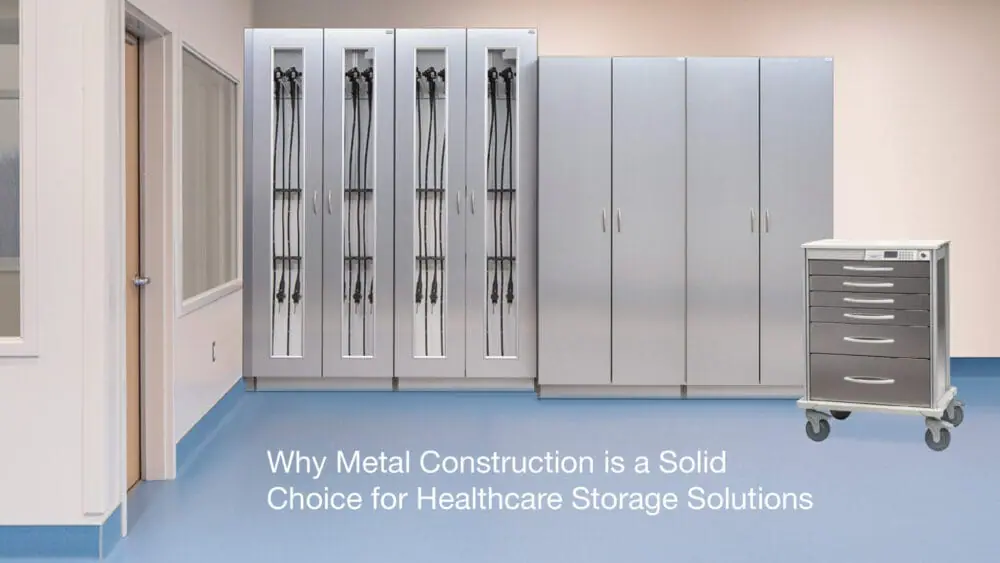
Metals have been used in healthcare since around 1500 BCE. Their first use may have been as medicine, such as treating headaches with copper and measles with gold.
In 1913, the invention of stainless steel revolutionized the medical materials industry. Stainless steel quickly became a staple in healthcare environments due to its durability and easy-to-clean surface.
Since the early 1900s, there have been advancements in materials science that have introduced new metals and plastics. In healthcare spaces, products must work to minimize the risk of infection. Materials science engineers aim to design surface materials which are resistant to biofilm formation while being environmentally safe.
Read on for a discussion about the current state of plastics in healthcare and which metals are best for storage products.
Plastics – Too Much of a Good Thing
Plastics are often preferred over other materials for producing lightweight and flexible medical products, especially for devices that are hard to clean.
Despite concerns raised by environmental health organizations about the use of single-use plastics in healthcare, they continue to make up a large portion of healthcare supplies. Research indicates that plastics are found in our water, food, and bodies.
Efforts have been made to increase the recycling of medical plastics, but the American Medical Association Journal of Ethics has reported that approximately one-quarter of medical waste is composed of plastics, and most of this waste is not recycled.
While plastics have a place in healthcare, replacing many metal supplies with plastic counterparts may have gone too far.
Plastics can be challenging to clean in a healthcare environment and are prone to deterioration with heavy use and age. Micro cracks and crevices can develop, making plastic healthcare products hard to clean and increasing the spread of infectious organisms.
Metals
Metals, such as stainless steel and titanium, revolutionized the world of medical devices due to their strength and resistance to corrosion.
Let’s look at two metals preferred for healthcare storage construction and one you might see more of in the future.
Stainless Steel
Type 304 stainless steel, commonly used in healthcare, contains at least 18 percent chromium, 8 percent nickel, and less than 0.08 percent carbon. Medical-grade stainless steel is nonmagnetic and highly desirable in healthcare settings where magnets are used, such as in magnetic resonance imaging.
Manchester Metropolitan University and AgroParis showed that stainless steel, even as it ages, can be disinfected to the same degree as new stainless steel. So there’s no reason to dispose of a stainless steel storage product because of its age.
Adding to the longevity of stainless steel is its ability to self-heal. In the presence of oxygen, the high percentage of chromium in medical-grade stainless steel produces a passive film that seals the surface and renders it inert. Any time the surface endures a scratch the chromium is exposed to oxygen again and heals itself with the formation of this passive film.
Here are some other key benefits of stainless steel medical cabinets and carts:
- Stainless steel is easy to clean with detergent and water.
- Stainless steel is a moldable material. Construction of storage shelves, containers, and drawers of any size, shape, and configuration is possible with stainless steel.
- Stainless steel is tough. Unlike plastic, stainless steel can withstand drops and tossed instruments without cracking or chipping.
- Stainless steel is resistant to corrosion from cleaning agents or other chemicals used in healthcare environments.
- While stainless steel is more expensive than some other materials, it will last for many years and is infinitely recyclable, making it an inexpensive choice over its lifespan.
- Stainless steel requires little maintenance and minimal repairs.
For fixed cabinets and smaller medical carts, stainless steel lends its strength and corrosion resistance to provide a durable product that will serve its purpose for many years.
Aluminum
Aluminum, like stainless steel, is a metal that is useful in healthcare applications due to its corrosion resistance and versatility.
Aluminum, like stainless steel, is moldable and nonmagnetic.
Aluminum is also lighter compared to stainless steel, making it a practical choice for storage products that must be regularly moved.
Aluminum, when used as a component of mobile storage carts such as anesthesia carts and code carts, can lighten the weight without compromising on longevity and corrosion resistance.
Copper
Copper is a naturally occurring metal with antimicrobial properties. Copper has been the subject of several studies that examined how well it can reduce bioburden when incorporated into medical surfaces.
A systematic review published in the American Journal of Infection Control suggested that copper surfaces work better than other hard surfaces to reduce bioburden that can develop in healthcare settings.
Research at this time is limited and the study authors state that further studies are needed to determine how well copper surfaces reduce healthcare-associated infections compared to other infection control practices, such as proper hand washing and isolation procedures.
Evolving Materials for Healthcare Storage Products
Stainless steel and aluminum are still the most common metals found in healthcare storage products. Easy to clean and durable, they help reduce biofilm build-up on their surfaces.
While stainless steel and aluminum reign supreme for the moment, materials continue to evolve in the medical storage industry. Metals like aluminum can even be combined with other materials to create storage products that combine the benefits of multiple materials, like InnerSpace’s AireCore products.
As studies are completed on the future of infection-fighting metal alloys, be on the lookout for additional material choices for your hospital storage solutions.

Cindy Blye
Content WriterCindy Blye, BSN, RN, CCM is a Registered Nurse and Certified Case Manager. She is an Alumni of West Virginia University School of Nursing (BSN), and a member of the Association of Health Care Journalists and The Authors Guild.
